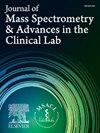基质辅助激光解吸/电离飞行时间质谱法和环境电离质谱法研究皮肤银屑病的潜在生物标志物
IF 3.4
4区 医学
Q2 MEDICAL LABORATORY TECHNOLOGY
Journal of Mass Spectrometry and Advances in the Clinical Lab
Pub Date : 2025-04-01
DOI:10.1016/j.jmsacl.2025.04.004
引用次数: 0
摘要
背景银屑病是一种慢性炎症性疾病,病因不明,可累及皮肤、指甲和关节,常伴有合并症。最近的研究表明,银屑病病变内代谢物的改变可能与炎症有关。研究皮肤炎症和免疫中的生物活性脂质介质或代谢物可能提供新的潜在生物标志物和治疗预测因子。方法采用热解吸-电喷雾电离质谱法和基质辅助激光解吸/电离飞行时间质谱法分别对银屑病患者和健康对照鳞片提取物中的胶体和多肽进行表征。然后将主成分分析(PCA)应用于这些数据,以确定牛皮癣患者与健康对照之间的潜在差异。结果与银屑病患者和健康对照组相比,银屑病斑块显示蜡酯和甘油三酯减少,人中性粒细胞防御素(HNPs)明显增加。此外,当银屑病患者接受药物治疗时,HNPs水平显着降低,这表明它们可能作为评估银屑病治疗效果的潜在生物标志物。结论两种质谱技术可快速、无创地鉴定和监测银屑病患者与健康对照者之间的潜在生物标志物。然而,PCA结果只显示出轻微的差异,我们打算在未来扩大样本基础,以增加调查的统计能力。本文章由计算机程序翻译,如有差异,请以英文原文为准。

Investigation of potential biomarkers for psoriasis in skin with matrix-assisted laser desorption/ionization time-of-flight mass spectrometry and ambient ionization mass spectrometry
Background
Psoriasis is a chronic inflammatory disease with an unclear etiology that affects skin, nails, and joints and often accompanies comorbidities. Recent studies indicate that alterations in metabolites within psoriatic lesions might be linked to inflammation. Studying bioactive lipid mediators or metabolites in skin inflammation and immunity might provide new potential biomarkers and therapeutic prediction factors.
Methods
Lipids and peptides in the scale extracts from psoriasis patients and healthy controls were characterized by thermal desorption-electrospray ionizationmass spectrometry and matrix-assisted laser desorption/ionization time-of-flightmass spectrometry, respectively. Principal component analysis (PCA) was then applied to these data to identify potential differences between psoriasis patients and healthy controls.
Results
Psoriatic plaques show reduced wax esters and triglycerides and a predominant increase in human neutrophil defensins (HNPs), compared to non-lesional sites of psoriatic patients and healthy control. Additionally, when medical treatments were administered to psoriasis patients, levels of HNPs were significantly reduced, suggesting that they may serve as potential biomarkers to evaluate therapeutic efficacy for psoriasis.
Conclusion
Two mass spectrometric techniques were used to rapidly and non-invasively identify and monitor potential biomarkers between psoriasis patients and healthy controls. However, PCA results only showed slight differences, and we intend to broaden the sample base in the future to increase the statistical power of the investigation.
求助全文
通过发布文献求助,成功后即可免费获取论文全文。
去求助
来源期刊

Journal of Mass Spectrometry and Advances in the Clinical Lab
Health Professions-Medical Laboratory Technology
CiteScore
4.30
自引率
18.20%
发文量
41
审稿时长
81 days
 求助内容:
求助内容: 应助结果提醒方式:
应助结果提醒方式:


